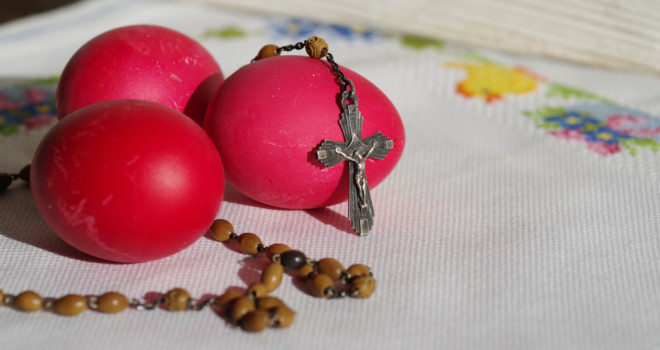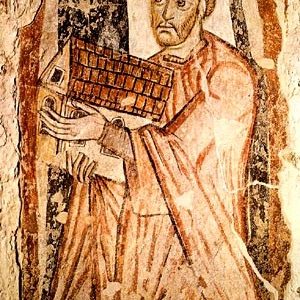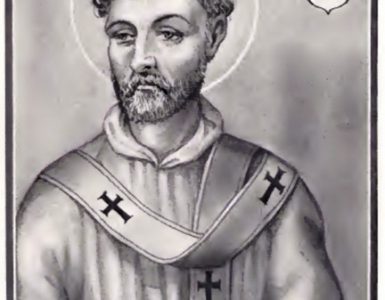Decorating eggshells, especially those of ostriches, predates the Christian tradition by at least 3,000 years. The ancient Sumerians and Egyptians commonly placed decorated eggs, or their representations in gold and silver, in graves.
Thus the Christian adaptation of decorating eggs can be traced to early Christians of Mesopotamia, who stained eggs red in memory of the blood Christ shed at his crucifixion. Moreover, the egg’s hard shell symbolized the sealed door of Christ’s tomb and its cracking His resurrection from the dead. St. Augustine described Christ’s Resurrection as a chick bursting from an egg.
According to tradition, patrician St. Mary Magdalene, at an audience in Rome with the Emperor Tiberius denounced Pilate for his scandalous handling of Jesus’ trial and told the Emperor “Christ has risen”. Unmoved the Emperor scathingly pointed to an egg on his table and announced: “Christ has no more risen than that this egg is red.” Instantaneously the emperor’s egg turned crimson.
Instead, a Polish legend recounts that, when Mary Magdalene went to Jesus’ tomb to anoint his body for burial, she was bringing cooked eggs to share with the other women there. She uncovered the basket and, when the risen Christ appeared to her, her eggs miraculously turned red. Still today eggs dyed red, especially in Eastern Europe, often accompany other traditional Easter foods.
The Roman Ritual, the first edition of which was published in 1610 but which contains texts of much older date, has among the Easter Blessings of Food, along with those for lamb, bread, and new produce, the following blessings for eggs, which were forbidden food during Lent as were meat and dairy products:
“Lord, let the grace of your blessing + come upon these eggs, that they be healthful food for your faithful who eat them in thanksgiving for the resurrection of our Lord Jesus, who lives and reigns with you forever and ever.”
Besides eggs, the symbol of Easter worldwide, now often made of chocolate, there are many traditional celebratory dishes. The most universal, in Eastern Europe, Greece, Italy, and the UK, is roasted milk-fed baby lamb, which have not yet tasted grass. Other local dishes are Pashka from Russia, a pyramid-shaped dessert made from cheese and often decorated with religious symbols, such as the letters XB for “Christos Voskros”, which means “Christ is Risen”; Pinca, Slovenia and Croatia, a large hot cross bun; Tsoureki, Greece, a brioche-like bread, flavored with an essence drawn from the seed of wild cherries and decorated with hardboiled eggs dyed red; Mona de Pascua, Spain, an Easter cake resembling a large doughnut topped with a hardboiled egg; the sweetly spiced Hot Cross Bun from the UK as are simnel cakes or fruit cakes topped with 11 or 12 marzipan balls to symbolize the Apostles; Capirotada, Mexico, a spicy bread pudding filled with raisins, cloves, cinnamon, and cheese. The cloves symbolize the nails, the cinnamon sticks the wooden cross, and the bread the body of Christ; Kulich, Bulgaria, Georgia, and Russia, a cake baked in a tall tin and decorated with white icing and colorful flower-shaped sprinkles; and Paçoca de Amendolm, Brazil, a sweet made from peanuts, sugar, and cassava flour.
In Italy there are many Easter cakes: the omnipresent dove-shaped Colomba similar in taste to the Christmas pannetone with its candied fruits and sugar-coated almonds; the Neapolitan pastiera, a pie doused with orange-blossom water and filled with ricotta, chocolate chips, candied fruit, grain and a hidden gold coin at its center; an Umbrian pungent pecorino cheese and grated pepper cake to eat with salami at Easter breakfast; and Sicilian, spun-sugar lambs, cassata and cannoli.
There’s an Italian saying: “Natale con i tuoi; Pasqua con chi vuoi” (“Christmas with your family and Easter with whomever you choose”). After the ubiquitous lasagna or ravioli stuffed with spinach and ricotta, and before the sweets, to accompany their lamb, artichokes, asparagus and fava beans are Italy’s favorite side dishes. Not to mention that Easter Monday, “Pasquetta” or “Lunedì dell’Angelo” is also a holiday and traditionally the first picnic/barbecue of the year.












